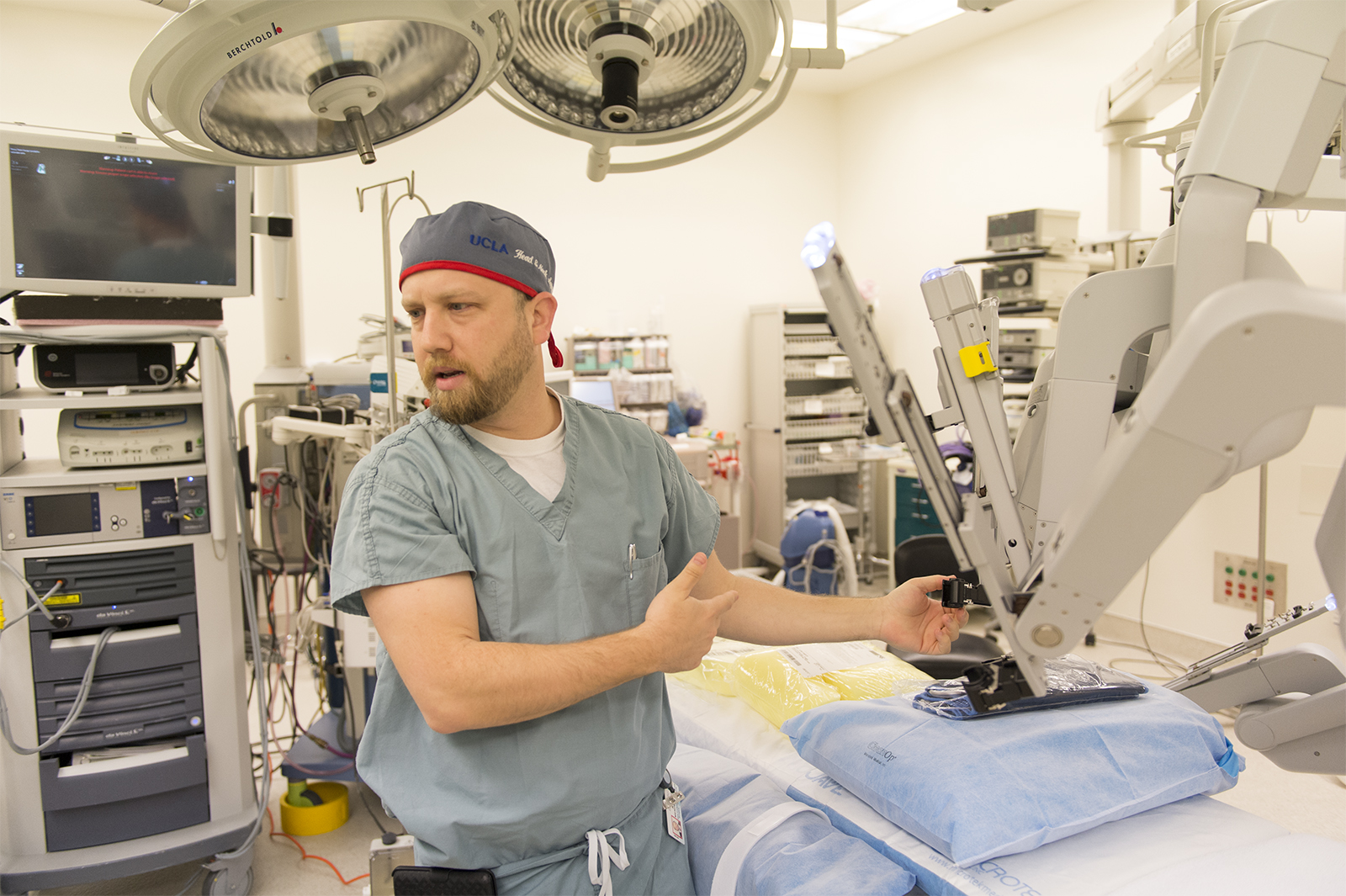UCLA doctor performs safer head and neck surgery with robots

Dr. Abie Mendelsohn has performed nearly 100 operations with this precise robotic tool housed in the Ronald Reagan UCLA Medical Center. (Max Himmelrich/Daily Bruin)
By Nikki Somani
Jan. 29, 2015 8:53 a.m.
Three years ago, David Alpern felt a lump in the back of his throat and went to see his doctor. His biopsy came back as tonsil cancer.
The surgery that his doctor described involves sawing open a patient’s jaw, removing the tumor and closing the jaw back up. Patients who receive the surgery need a breathing tube and temporary feeding tube for about one week after the surgery, with risk of substantial bleeding and nerve damage that could lead to an inability to swallow correctly.
“The first thing (the doctor) described to me was the surgery where they split your face open,” Alpern said. “My mind just shut down.”
But this invasive surgery wasn’t Alpern’s only option. Alpern’s doctor had heard about Dr. Abie Mendelsohn, director of head and neck robotic surgery at UCLA, who was just beginning to perform transoral robotic surgery at the Ronald Reagan UCLA Medical Center.
Mendelsohn told Alpern that he could perform the surgery by controlling a robot. The robot would extend to the back of the mouth in areas where human surgeons could not, and would therefore remove the tumor without splitting his jaw.
Robotic surgery is becoming an increasingly common technique across the country. Mendelsohn said he performed the first head and neck robotic surgery at UCLA in 2010. Since then, he has performed almost 100 robotic surgeries at the Ronald Reagan UCLA Medical Center.
Recently, Mendelsohn helped develop a technique that allows the robot to operate on previously unreachable areas of the deep neck. The first robotic surgery to remove a deep neck tumor at UCLA was successfully performed last year.
The robot that Mendelsohn uses has arms with probes that can reach inside of a body to areas unreachable by a surgeon’s hands. One arm holds a camera that follows the probes, projecting the image for the surgeon to see while he is controlling the machine from about 6 feet away.
“What we see are patients who are doing better, getting out the hospital faster, getting better results from a cancer perspective,” Mendelsohn said.
UCLA uses the da Vinci Surgical System, which is manufactured by the company Intuitive Surgical. Each robot costs about $1.8 million.
Robotic surgery is performed at the hospital in a number of different departments, including head and neck surgery, thoracic surgery, cardiac surgery, urology and gynecology. The hospital currently houses two da Vinci robots that about 25 surgeons are trained to use.
“(The robot) provides the surgeon the level of dexterity and the level of visual perspective that no other tool can provide,” said Jacob Rosen, a UCLA professor of mechanical and aerospace engineering whose lab constructs surgical robots.
The main advantage of the robot is that it can get around areas with many blood vessels, such as in cardiac surgery. In addition, the surgeon can rotate the robot arms around 720 degrees, with a greater degree of freedom and flexibility than a human hand.
Mendelsohn said he became interested in robotic surgery because it had the potential to move his surgical field forward.
“Robotic surgery was able to offer a minimally invasive approach, better patient outcomes, the use of advanced technology,” Mendelsohn said. “I knew that that was something that always interested me.”
Mendelsohn said he was excited to help bring the head and neck robotic surgery technique to UCLA because he thinks it’s the best alternative for many patients. But for Alpern, the decision to choose robotic surgery wasn’t always clear-cut.
“The surgery was pretty scary because it was relatively new, having a robot and everything,” Alpern said. “I was a little hesitant about that.”
But after learning more about the procedure, Alpern decided to undergo the robotic surgery, a choice he said he’s grateful he made. Within a week after the surgery, Alpern was able to swallow properly, and within a month, he completely recovered.
Alpern was one of the first patients who underwent head and neck robotic surgery at UCLA.
“When you’re able to offer somebody a treatment that has no other options, it’s such a thrilling opportunity,” Mendelsohn said.
The minimum training required for surgeons to use the robot at UCLA is one week of orientation as well as practice with animals and cadavers. Surgeons are also recommended to undergo a fellowship that lasts six to 12 months, where they receive advanced training.
Mendelsohn said one of the biggest challenges right now is adequately training medical students and residents to use the robots. This spring, UCLA will launch an advanced training program, which Mendelsohn said he hopes will be the start of comprehensive robotic surgery education.
Mendelsohn said he predicts that within the next decade, robots will be used in every major city in the United States.
“It’s the best, most technologically advanced tool,” Mendelsohn said. “Some people use a scissor, some people use a laser. I just happen to use a robot.”


